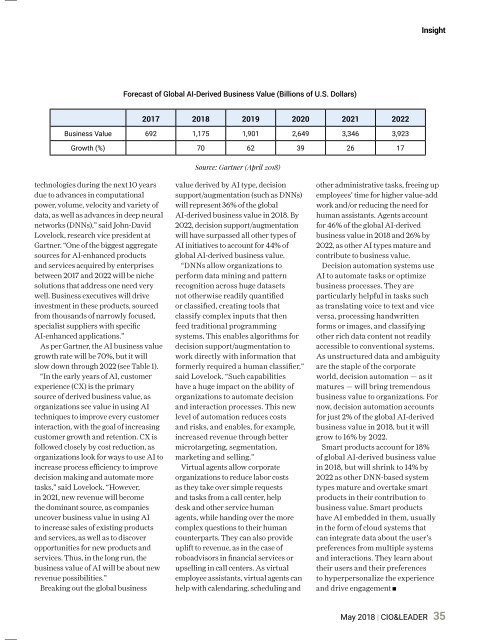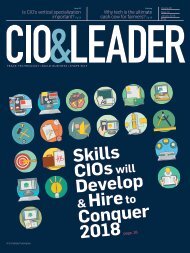C&L May 2018
You also want an ePaper? Increase the reach of your titles
YUMPU automatically turns print PDFs into web optimized ePapers that Google loves.
Insight<br />
Forecast of Global AI-Derived Business Value (Billions of U.S. Dollars)<br />
2017 <strong>2018</strong> 2019 2020 2021 2022<br />
Business Value 692 1,175 1,901 2,649 3,346 3,923<br />
Growth (%) 70 62 39 26 17<br />
Source: Gartner (April <strong>2018</strong>)<br />
technologies during the next 10 years<br />
due to advances in computational<br />
power, volume, velocity and variety of<br />
data, as well as advances in deep neural<br />
networks (DNNs),” said John-David<br />
Lovelock, research vice president at<br />
Gartner. “One of the biggest aggregate<br />
sources for AI-enhanced products<br />
and services acquired by enterprises<br />
between 2017 and 2022 will be niche<br />
solutions that address one need very<br />
well. Business executives will drive<br />
investment in these products, sourced<br />
from thousands of narrowly focused,<br />
specialist suppliers with specific<br />
AI-enhanced applications.”<br />
As per Gartner, the AI business value<br />
growth rate will be 70%, but it will<br />
slow down through 2022 (see Table 1).<br />
“In the early years of AI, customer<br />
experience (CX) is the primary<br />
source of derived business value, as<br />
organizations see value in using AI<br />
techniques to improve every customer<br />
interaction, with the goal of increasing<br />
customer growth and retention. CX is<br />
followed closely by cost reduction, as<br />
organizations look for ways to use AI to<br />
increase process efficiency to improve<br />
decision making and automate more<br />
tasks,” said Lovelock. “However,<br />
in 2021, new revenue will become<br />
the dominant source, as companies<br />
uncover business value in using AI<br />
to increase sales of existing products<br />
and services, as well as to discover<br />
opportunities for new products and<br />
services. Thus, in the long run, the<br />
business value of AI will be about new<br />
revenue possibilities.”<br />
Breaking out the global business<br />
value derived by AI type, decision<br />
support/augmentation (such as DNNs)<br />
will represent 36% of the global<br />
AI-derived business value in <strong>2018</strong>. By<br />
2022, decision support/augmentation<br />
will have surpassed all other types of<br />
AI initiatives to account for 44% of<br />
global AI-derived business value.<br />
“DNNs allow organizations to<br />
perform data mining and pattern<br />
recognition across huge datasets<br />
not otherwise readily quantified<br />
or classified, creating tools that<br />
classify complex inputs that then<br />
feed traditional programming<br />
systems. This enables algorithms for<br />
decision support/augmentation to<br />
work directly with information that<br />
formerly required a human classifier,”<br />
said Lovelock. “Such capabilities<br />
have a huge impact on the ability of<br />
organizations to automate decision<br />
and interaction processes. This new<br />
level of automation reduces costs<br />
and risks, and enables, for ex<strong>amp</strong>le,<br />
increased revenue through better<br />
microtargeting, segmentation,<br />
marketing and selling.”<br />
Virtual agents allow corporate<br />
organizations to reduce labor costs<br />
as they take over simple requests<br />
and tasks from a call center, help<br />
desk and other service human<br />
agents, while handing over the more<br />
complex questions to their human<br />
counterparts. They can also provide<br />
uplift to revenue, as in the case of<br />
roboadvisors in financial services or<br />
upselling in call centers. As virtual<br />
employee assistants, virtual agents can<br />
help with calendaring, scheduling and<br />
other administrative tasks, freeing up<br />
employees’ time for higher value-add<br />
work and/or reducing the need for<br />
human assistants. Agents account<br />
for 46% of the global AI-derived<br />
business value in <strong>2018</strong> and 26% by<br />
2022, as other AI types mature and<br />
contribute to business value.<br />
Decision automation systems use<br />
AI to automate tasks or optimize<br />
business processes. They are<br />
particularly helpful in tasks such<br />
as translating voice to text and vice<br />
versa, processing handwritten<br />
forms or images, and classifying<br />
other rich data content not readily<br />
accessible to conventional systems.<br />
As unstructured data and ambiguity<br />
are the staple of the corporate<br />
world, decision automation — as it<br />
matures — will bring tremendous<br />
business value to organizations. For<br />
now, decision automation accounts<br />
for just 2% of the global AI-derived<br />
business value in <strong>2018</strong>, but it will<br />
grow to 16% by 2022.<br />
Smart products account for 18%<br />
of global AI-derived business value<br />
in <strong>2018</strong>, but will shrink to 14% by<br />
2022 as other DNN-based system<br />
types mature and overtake smart<br />
products in their contribution to<br />
business value. Smart products<br />
have AI embedded in them, usually<br />
in the form of cloud systems that<br />
can integrate data about the user's<br />
preferences from multiple systems<br />
and interactions. They learn about<br />
their users and their preferences<br />
to hyperpersonalize the experience<br />
and drive engagement<br />
<strong>May</strong> <strong>2018</strong> | CIO&LEADER<br />
35














